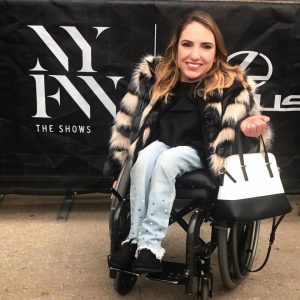
 The characteristics of SA/CRS vary greatly. It is a condition that can be so extensive that it is not compatible with a live birth or so minimal as to go unnoticed and undiagnosed for years, or even a lifetime. It is a diagnosis that describes the absence of specific physical structures of the body, specifically the lower part of the spine and spinal cord, but there are also differences that occur with other parts of the body that may, or may not be, associated with the absence of part of the spine. Regardless of variations in which this condition presents in individuals, it is important to note the photos above, which verify that individuals born with SA/CRS can lead happy, active and productive lives. For a chart of characteristics based on reporting of 60 individuals click here. (This chart is large and not easily viewed on a cell phone. For a downloadable PDF copy click here.)
The characteristics of SA/CRS vary greatly. It is a condition that can be so extensive that it is not compatible with a live birth or so minimal as to go unnoticed and undiagnosed for years, or even a lifetime. It is a diagnosis that describes the absence of specific physical structures of the body, specifically the lower part of the spine and spinal cord, but there are also differences that occur with other parts of the body that may, or may not be, associated with the absence of part of the spine. Regardless of variations in which this condition presents in individuals, it is important to note the photos above, which verify that individuals born with SA/CRS can lead happy, active and productive lives. For a chart of characteristics based on reporting of 60 individuals click here. (This chart is large and not easily viewed on a cell phone. For a downloadable PDF copy click here.)
As the infant develops during pregnancy, many structures develop at the same time. The development of these structures can be influenced by genetic factors and by environmental factors in the womb.
Read more about genetic factors here.
Early in the pregnancy, at the same time that the spine is developing, the heart, kidneys, reproductive organs, renal/urinary organs, and digestive organs are all developing too. A genetic or environmental factor in the pregnancy that impacts one of these organs may also impact other organs. A gene might be present, or absent, that prevents, or increases, the presence of certain enzymes or hormones. These hormones might be responsible for stimulating or reducing growth or development of specific structures or of multiple structures in the infant. The genetic impact might be an inherited trait, or a spontaneous change in a gene. There might not be any genetic factor at all. There may be an environmental factor, in the womb that has some impact on the development of structures in the infant. Both environmental and genetic factors may combine or influence development in different ways. SA/CRS is thought to be caused at least in some cases by a combination of environmental and genetic factors but these factors are unknown.
Describing all of the characteristics of SA/CRS is complicated because:
- SA/CRS may be present as a primary condition
or
- May be part of another more extensive condition or syndrome such as VACTERL
or
- May occur along with other unrelated conditions or syndromes.
SA/CRS may impact:
- only one small part of a very few structures in the body
or
- more extensive parts of multiple structures of the body
SA/CRS may be
- Invisible because physical and functional changes to parts of the body are only seen in an MRI/xray such as kidneys, pelvis, small portions of the lower spine and spinal cord.
And/ or
- visible due to physical and functional changes to external parts of the body such as torso, hips, legs and/or feet
Characteristics specific to SA/CRS:
There are many conditions that have something to do with the formation of the spine. SA/CRS may appear to be similar to some of those other conditions, such as spina bifida or sirenomelia, but it has some characteristics that other conditions do not and appears to have a cause or cause(s) that differ from any other condition.
- While other conditions may involve changes in the shape of the spine or function and appearance of the spinal cord, SA/CRS always involves the partial or complete absence of the sacrum, the lowest part of the spine. The absence of the spine may extend much further up in to the torso, to the mid-thoracic level.
- When the lower spine is absent, the connection to the pelvis is altered. The shape and size pelvis itself may be impacted.
- There are 4 different categories of SA/CRS describing various ways in which the pelvis and the remaining spine appear.
When the lower spinal cord is absent, the function as well as sometimes the size and appearance of structures of the body may be impacted. Similar impact to these parts of the body would be likely to occur in any congenital condition where there is damage to the spinal cord.
- Legs or parts of legs may be completely or partially paralyzed
- Muscle atrophy, as a result of the paralysis may be present
- structural/growth changes of the pelvis, hips, legs and feet of the developing fetus (feet may be clubbed or rocker bottom, hips may be dislocated, pelvis may be small, ankle and/or knee joints may be fused in a bent or straight position.)
Learn more about joint fixation here.
Learn more about size and weight here.
- The function of the bowel and bladder may be reduced (neurogenic bowel/bladder)
Additional related characteristics
There are additionally some characteristics that are present in many individuals with SA/CRS and for no other apparent reason than the condition of SA/CRS itself. These characteristics don’t typically appear in the same way as other conditions that impact the spine. These characteristics are not always present for every individual with SA/CRS, but they do occur with high frequency in the SA/CRS population:
- Differences in the shape, function or presence of the kidney
o One kidney may be absent
o Both kidneys may be fused together
o One or both kidneys may have a “horseshoe shaped appearance
o One kidney may be significantly smaller than the other
- Specific formation changes to the shape and size of the lower limbs
o Webbing may be present between the upper thigh and the lower calf
o Knee Joints may be fixed/fused in a bent position(with our without webbing)
o Knee joints may be fixed in a straight or hyperextended position
o The size of the legs may be significantly smaller as compared to the rest of the body
- Differences of the bone formation of other parts of the spine and ribs
o Some spinal vertebrae may be fused together
o Curves in the spine including lordosis, kyphosis and scoliosis may be present
o Some spinal vertebrae may be “butterfly vertebrae” in shape
o Some spinal vertebrae in the cervical area may be absent or small
o There may be a ‘lump’/’bump’ in the back where the spine ends
o The spinal cord may be tethered
o A rib may be missing or fused
- Differences in the pelvic and urogenital and anal area
o The pelvis may be very small in comparison to the rest of the body
o The buttocks may be flat
o Legs may be widely splayed outward from hips
o Dimples may be present above the buttocks area (sacral dimple)
o Genital area may be small or have different in formation than found in the general population
o Anal region may be closed (anal atresia)
o Reproductive organs may be partially or totally absent(rare)
Characteristics related to the level of spinal agenesis
The more vertebrae absent, the more impact to the lower limb function. For those with only partial absence in the sacral bone region, the physical features of the lower limbs may appear to have full form and function. In that case, the primary impact of SA/CRS may be related to bowel and bladder function because the lowest area of the spinal cord sends and receives messages for bowel and bladder function. Or, the individual with partially absent sacrum may have somewhat smaller calves, some structural differences with the feet and/or ankles such as clubfoot or reduced range of motion of the toes, feet, ankles and knees. If one side of the sacrum is absent, the function and size of the leg on that side may be reduced as compared to the function on the other side.
For those with more extensive absence of the spine into the lumbar region, lower limbs are usually more significantly impacted in formation, characteristically involving some kind of knee and ankle fixation at joints in either the bent, straight, or hyperextended leg position for both legs and notable small size of lower limbs. The physical appearance and function of the lower limbs when the spine is absent in the lumbar region varies greatly. Bowel and bladder function is impacted.
When the absence of the spine continues into the thoracic region, it is most common to see bent leg fixation, often with webbing between thigh and calf. This characteristic is sometimes called the “frog leg” or “Buddha” sitting position. Although this characteristic may also occur with spine absent in the lumbar region, it is almost always present when the spine is absent into the thoracic region. This characteristic might be considered a hallmark of the condition because it is unique in appearance and does not occur with other spinal conditions.
Is it related to SA/CRS or not?
There is still much to learn about the condition of SA/CRS. There are often questions about other conditions such as hearing loss, extra digits on the hand(s) or Goldenhars syndrome and concerns about whether these additional conditions are related to SA/CRS or not. Sometimes these conditions occur in the SA/CRS population with no more frequency than one might expect in the general population. Some of these conditions occur with more frequency than they do in the general population, but are still not widely typical in the SA/CRS population. To help sort this question of what is related to SA/CRS and what is not (a question that cannot be precisely answered at this time), a collection of characteristics has been put in a chart. The chart provided in the next page of this site divides the characteristics into 4 columns.
See this chart of characteristics here
- those known to be associated with SA/CRS
- those occurring in addition to SA/CRS more frequently than in the general combination, but not directly linked to SA/CRS
- those reported but in less than 2 individuals of all reporting, perhaps not more frequent in SA/CRS population than in the general population.
- Syndromes identified which may include SA/CRS or which may be found with more frequency in populations of individuals with SA/CRS than in the general population
Reading through a listing all of the possible characteristics of a condition can feel overwhelming, especially to new parents who imagine that their child might have every single characteristic listed. The information in the chart presented in this menu represents data collected from 60 individuals with SA/CRS, and no single individual has all of these characteristics.
